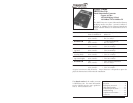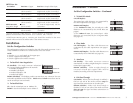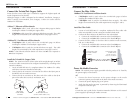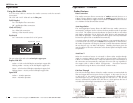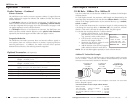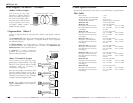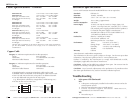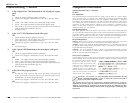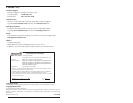
8
SBFTF10xx-10x
24-Hour Technical Support: 1-800-260-1312 -- International: 00-1-952-941-7600
Operation -- Continued
Product Features -- Continued
Distance Extension
The SBFTF10xx-10x media converter segments 10Base-T copper Ethernet
and/or 100Base-TX copper fast Ethernet and 100Base-FX fiber fast Ethernet
collision domains.
In a half-duplex Ethernet or fast Ethernet environment, the SBFTF10xx-10x
media converter extends network distances by segmenting collision domains
so that the 5-Segment Rule (see page 10) or the 512-Bit Rule (see pages 9 and
10) applies separately to each collision domain.
In a full-duplex Ethernet or fast Ethernet environment, the SBFTF10xx-10x
media converter extends network distances to the physical cable limitations
imposed by the selected copper and fiber cables (see pages 1 and 2).
Congestion Reduction
The SBFTF10xx-10x media converter does not forward collision signals or
error packets from one collision domain to another, improving baseline
network performance. In addition, the media converter filters packets
destined for local devices, also reducing network congestion.
Optional Accessories
(sold separately)
Part Number Description
SPS-1872-SA Optional External Power Supply; 18-72VDC Stand-Alone
Output: 12.6VDC, 1.0 A
SPS-1872-PS Optional External Power Supply; 18-72VDC Piggy-back;
Output: 12.6VDC, 1.0 A
E-MCR-04 12-Slot Media Converter Rack (includes universal internal power
supply) 17 x 15 x 5 in. (432 x 381 x 127 mm)
WMBL Optional Wall Mount Brackets; Length: 4.7in. (119mm)
WMBV Optional Vertical Mount Bracket; Length: 5.0 in. (127 mm)
WMBD Optional DIN Rail Mount Bracket; Length: 5.0 in. (127 mm)
WMBD-F Optional DIN Rail Mount Bracket (flat); Length: 3.3in. (84 mm)
techsupport@transition.com -- Click the “Transition Now” link for a live Web chat.
9
Half-Duplex Network
512-Bit Rule - 100Base-TX or 100Base-FX
Use the 512-Bit Rule to calculate the 100Base-TX or 100Base-FX half-duplex
collision domain.
In a half-duplex network, the maximum cable lengths are determined by the
round trip delay limitations of each fast Ethernet collision domain. (A collision
domain is the longest path between any two terminal devices, e.g. a terminal,
switch, or router.)
The 512-Bit Rule determines the maximum length of cable permitted by
calculating the round-trip delay in bit-times (BT) of a particular collision
domain. If the result is less than or equal to 512 BT, the path is good.
To calculate the round-trip delay for a collision domain:
1. Find the collision domain, i.e. the longest
path between any two terminal devices
(e.g., terminal, switch, and/or router).
2. Calculate the round-trip delay in bit-
times for each length of cable.
4. Determine the bit-time values for each
device (see table to the right).
3. Add the bit-time values for each length of
cable and the bit-times for each device.
NOTE: The 512-Bit Rule applies separately to each collision domain.
100Base-TX Twisted-Pair Example
In the example below, the SBFTF10xx-10x 2-Port bridging media converter
acts as a switch. In this case, the collision domain bound by the media
converter on one end and a terminal on the other.
Since the total of the bit-times in this example is less than 512 (see chart
below), the path is good.
100 meters TP
cross-over
= 111BT
terminal
= 50 BT
media converter
= 50BT
10 meters TP
cross over
= 11.1BT
class II hub
= 92BT
class II hub
= 92BT
10 meters TP
straight-through
= 11.1BT
Sum of the bit-times for the example collision domain:
Media converter = 50.0 BT
100 m TP cable (100m x 1.11 BT/m) = 111.0 BT
Two Class II hubs (2 x 92) = 184.0 BT
Two 10 m TP cables (2 x 10m x 1.11 BT/m) = 22.2 BT
Terminal = 50.0 BT
Total = 417.2 BT
Class I hub 140 BT
Class II hub 92 BT
terminal/router 50 BT
1 meter TP cable 1.11 BT
1 meter fiber cable 1 BT
Fast Ethernet switch 50 BT
SBFTF10xx-10x 50 BT



